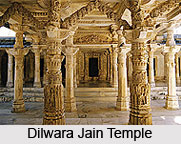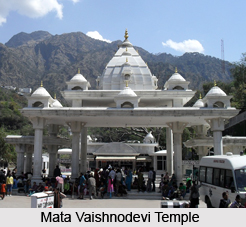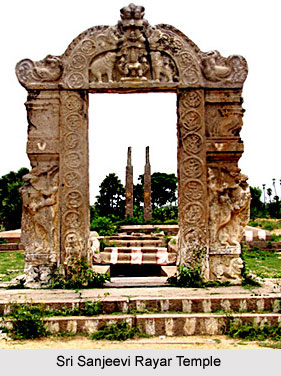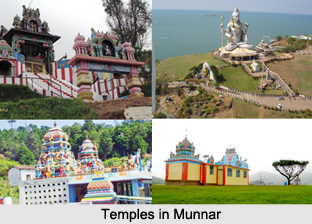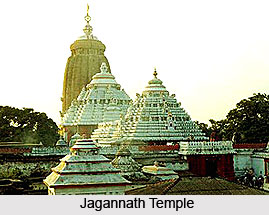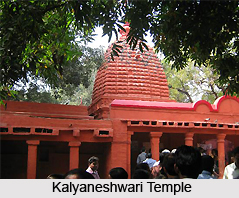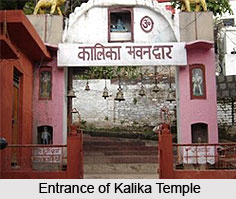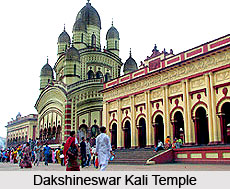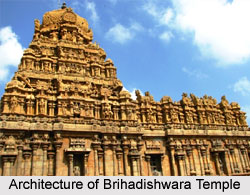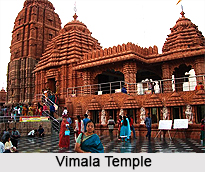 Vimala Temple is a Hindu temple dedicated to Goddess Vimala, located within the Jagannath Temple complex in Puri in the Indian state of Odisha. It is generally regarded as a Shakti Pitha, among the holiest temples dedicated to the Hindu Goddess. This temple stands as a monument for the predetermined years when Puri was a genuine Shakti Pitha. Vimala is considered to be the Tantric consort of Jagannath and a guardian of the temple complex. Devotees pay respect to Vimala before worshipping Jagannath in the main temple. Food offered to Jagannath does not get sanctified as "Mahaprasad" until it is also offered to Vimala. The people of Orissa take pride in the Vimala temple. They consider it the most important temple to the Goddess and a must-visit.
Vimala Temple is a Hindu temple dedicated to Goddess Vimala, located within the Jagannath Temple complex in Puri in the Indian state of Odisha. It is generally regarded as a Shakti Pitha, among the holiest temples dedicated to the Hindu Goddess. This temple stands as a monument for the predetermined years when Puri was a genuine Shakti Pitha. Vimala is considered to be the Tantric consort of Jagannath and a guardian of the temple complex. Devotees pay respect to Vimala before worshipping Jagannath in the main temple. Food offered to Jagannath does not get sanctified as "Mahaprasad" until it is also offered to Vimala. The people of Orissa take pride in the Vimala temple. They consider it the most important temple to the Goddess and a must-visit.
History of Vimala Temple
The central icon of Vimala is of 6th Century. The present structure has been built in the 9th Century under the Eastern Ganga dynasty, possibly over ruins of an earlier temple. The sculptures reflect the Somavamshi style. The temple was constructed by Yayati Keshari, a ruler of Somavamshi Dynasty.
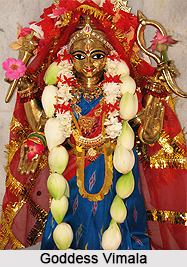 Architecture of Vimala Temple
Architecture of Vimala Temple
The temple is located in the south-west corner of the inner enclosure of the Jagannath temple complex next to the sacred pond "Rohini Kund". The temple faces towards east and is built of sandstone and laterite. It is built in the Deula style that has 4 components namely, "Vimana", "Jagamohana", "Nata Mandapa" and "Bhoga Mandapa". The temple is maintained and was renovated around 2005 by the Archaeological Survey of India, Bhubaneswar.
Idol of Goddess Vimala
Goddess Vimala is deified within the sanctum that is devoid of wall decorations. She holds no weapons normally attributed to "Goddess Durga". The icon is installed on a "Simhasana" (lion-throne), adorned with the figures of the goddess female attendants "Chhaya" and "Maya" on the sides. The image is 4 feet tall and is said to be made of "Lakha", a type of wax. Vimala Temple enshrines 7 Mother Goddesses that include "Brahmi", "Maheshwari", "Andri", "Kaumari", "Vaishnavi", "Varahi" and "Chamunda".
Food Offerings at Vimala Temple
Generally, no separate food offerings are cooked for Goddess Vimala. The goddess is described to survive on the remnants which are referred as "Ucchishta" of Jagannath"s meals. The vegetarian food offerings to Jagannath are offered to Vimala, after which they are sanctified as Mahaprasad. During Durga Puja, Vimala is offered non-vegetarian food and animal sacrifice, traditionally offered to the Hindu Mother Goddess.
Legend of Offerings at Vimala Temple
The legend narrates the tale behind the tradition of offering the Ucchishta, which otherwise is a taboo in Hinduism. Once, Lord Shiva on a visit to Lord Vishnu`s abode Vaikuntha. Mahavishnu just finished his meals and few food grains had fallen on the ground. Shiva quickly picked up a grain and swallowed it. Unknown to him, half of it stuck to his beard. He headed back to Kailash where Narada sees the half grain, took and ate it. Parvati, Shiva"s consort, was upset that her rightful share of Vishnu`s prasad had been consumed by Narada Muni. In a peeved mood, she went to Vishnu and complained. Vishnu pacified her saying that in the Kali Yuga, she would live at Puri as Vimala, and would daily eat the remnants of his food.
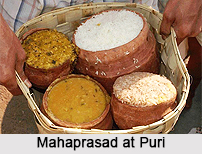 In Vijayadashami, separate food is cooked for the goddess is when she is offered non-vegetarian offerings. The goddess is considered to assume a destructive form during the festival and the meat is considered necessary to placate her. In strict secrecy during the pre-dawn hours, animal sacrifice of a he-goat is offered in the temple, while fish from the sacred Markanda Temple tank are cooked and offered to Vimala, as per Tantric rituals. The rituals have to be completed before the doors of the main sanctum of the vegetarian Jagannath are opened at dawn and the first morning Aarti is offered to the god. Only a few who witness the ceremony are given the prasad.
In Vijayadashami, separate food is cooked for the goddess is when she is offered non-vegetarian offerings. The goddess is considered to assume a destructive form during the festival and the meat is considered necessary to placate her. In strict secrecy during the pre-dawn hours, animal sacrifice of a he-goat is offered in the temple, while fish from the sacred Markanda Temple tank are cooked and offered to Vimala, as per Tantric rituals. The rituals have to be completed before the doors of the main sanctum of the vegetarian Jagannath are opened at dawn and the first morning Aarti is offered to the god. Only a few who witness the ceremony are given the prasad.
Religious Significance of Vimala Temple
Vimala Temple is considered one of the Shakti Pithas, the most sacred temples of the Hindu Goddess, identified with Parvati or Durga as consort of the Lord Shiva. It is said that Goddess Vimala appeared where the crown of Goddess Sati fell on earth. This temple is one among the 51 Shakti Pithas. Another popular concept is that the navel fell in Puri in Orissa, where there is a famous temple dedicated to Goddess Vimala within the perimeters of Jagannath temple. In Puri, Goddess Vimala is the consort of Purushottam Jagannath, the form of Maha Vishnu or Sri Krishna.
Festivals at Vimala Temple
The Goddess oriented festival of Durga Puja in the month of October is celebrated for 16 days at the temple, culminating with Vijayadashami. On Vijayadashami, Vimala is worshipped by the titular Gajapati Empire of Puri as the Goddess Durga. As the goddess is believed to assume a destructive aspect during the Durga Puja, women are debarred in the temple as they are considered too "weak-hearted" to witness this terrible form of the goddess.
Visiting Information
Several private and state transport services are available from the station to reach the temple complex. Puri has its own railway station which connects it to numerous cities while Bhubaneswar is also connected to most of the major Indian cities. The nearest airport is located at Bhubaneshwar which 56 km away.












